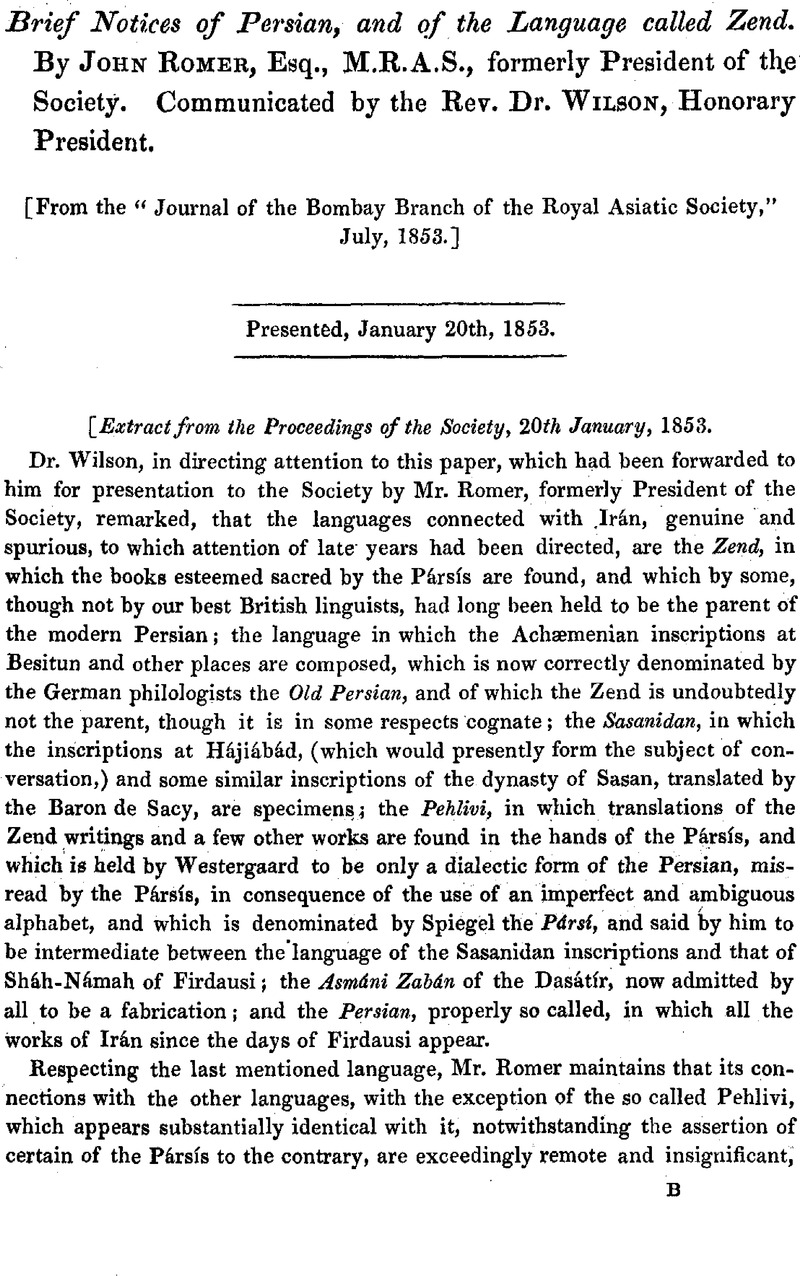No CrossRef data available.
Published online by Cambridge University Press: 14 March 2011

* This appears capable of satisfactory explanation, if, on examination, Sanskrit words, employed in the construction of Zend, are found among those to whom these analogies, and they abound, can be distinctly traced.—J. R.
† Moses of Chorone, as appears in his History of Armenia, written five hundred years before Firdausi, was acquainted with what he designated the fables of Persia, and among them quotes the story of Zohak and his two serpents.—Bom. Lit. Trans, vol. ii. p. 152.Google Scholar
* [This is done in many works of the Pársís, both in print and MS. Yet, with as much absurdity on the other hand, it is alleged in the Dasátír that Alexander himself became a convert to Zoroastrianism!—J. W.]
† Kennedy, taking part of the text, found, in passages of one thousand couplets each—in the first thousand, fifty-four Arabic words; in the second, thirty; and in the third, forty-six: not quite five words to each hundred verses.
* Finlay's History of Greece.
* [The oldest Zend MS. of the Vendidád now in the possession of the Pársís of India bears the date a.y.1987 (a. d. 1617). It was written in Persia. A portion of the Vendidád, however, sold by them to Professor Rask, and now in the Royal Library at Copenhagen, bears the date of a. y.673 (a. d. 1303), which Professor Westergaard considers genuine. A fragment of the same MS., or of another of the same time and place (Cambay), is in London. A copy of the Yaçna, also from Cambay, and now at Copenhagen, was written a. y. 692 (a. d. 1322). The other Zend MSS. at Copenhagen, Paris, London, Oxford, and in my own collection in Bombay, with the exception of a single fragment, perhaps, are of posterior dates.—J. W.]
* Researches, &c. p. 168.
† Wilson, on the Parsl Religion, p. 402.Google Scholar
* Pársí, Religion, p. 400.Google Scholar
† The Pársís of India were not entirely unlearned, for we know that three centuries ago they had translated the Pehlivi version of the Vendidád into Sanskrit.
* Historical and Geographical Description of Formosa. London: 1704.
* [Mullá Rustamjí informs me that his learned uncle, the late Mullá Firuz, had come pretty much to the same opinion.—J.W.]
* Abridged from Researches, pp. 165, 166.Google Scholar
* A perfect system of letters ought to contain one specific symbol for every sound used in pronouncing the language to which they belonged. In this respect the Old Persian or Zend approaches to perfection.—Sir William Jones.
† There are also some Sanskrit aspirates under arbitrary forms of letters, unknown to the ancient Persian alphabet, and this shows the attention paid to using Sanskrit with effect.
‡ In regard to analogies, it might have been added, that the attempt to identify the Bengali word bohini with the Sanskrit word svasri, by the permutation and excision of letters, shows how far a philologist may be misled who misapplies his rules, and permits fancy to supersede judgment.—Edinburgh Review, October, 1851.Google Scholar
[The Bengal bohini is obviously derived from the Sanskrit bhagini(a), a sister. The word svasri has its correspondents in the German schtvester and English sister.—J. W.]
(a) From this word, likewise, comes the Hindostani bahin.—J. R.